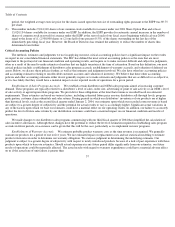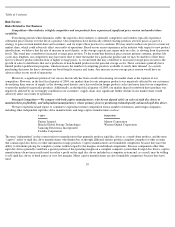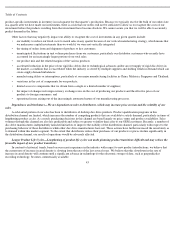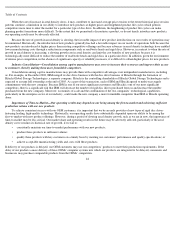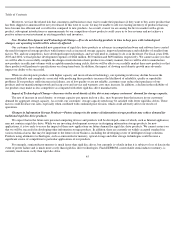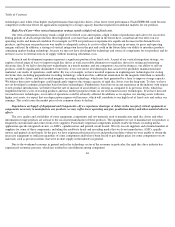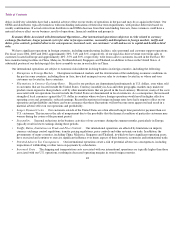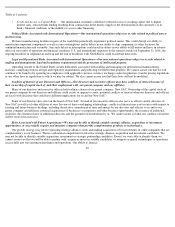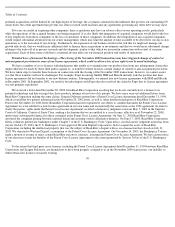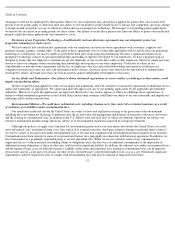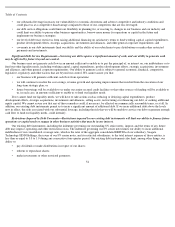Seagate 2003 Annual Report Download - page 47
Download and view the complete annual report
Please find page 47 of the 2003 Seagate annual report below. You can navigate through the pages in the report by either clicking on the pages listed below, or by using the keyword search tool below to find specific information within the annual report.
Table of Contents
technologies and, while it has higher read performance than rigid disc drives, it has lower write performance. Flash EEPROM could become
competitive in the near future for applications requiring less storage capacity than that required in traditional markets for our products.
High Fixed Costs—Our vertical integration strategy entails a high level of fixed costs.
Our vertical integration strategy entails a high level of fixed costs and requires a high volume of production and sales to be successful.
During periods of decreased production, these high fixed costs have had, and could in the future have, a material adverse effect on our
operating results and financial condition. For example, in 1998 our predecessor experienced a significant decrease in the demand for its
products, and because our predecessor was unable to adequately reduce its costs to offset this decrease in revenue, its gross and operating
margins suffered. In addition, a strategy of vertical integration has in the past and could in the future delay our ability to introduce products
containing market-leading technology, because we may not have developed the technology and source of components for our products and do
not have access to external sources of supply without incurring substantial costs.
Research and development expenses represent a significant portion of our fixed costs. As part of our vertical integration strategy, we
explore a broad range of ways to improve rigid disc drives as well as possible alternatives to rigid disc drives for storing and retrieving
electronic data. If we fail to develop new technologies in a timely manner, and our competitors succeed in doing so, our ability to sell our
products could be significantly diminished. Conversely, if we over invest in technologies that can never be profitably manufactured and
marketed, our results of operations could suffer. By way of example, we have incurred expenses in exploring new technologies for storing
electronic data, including perpendicular recording technology, which involves a different orientation for the magnetic field than is currently
used in rigid disc drives, and heat assisted magnetic recording technology, which uses heat generated by a laser to improve storage capacity.
We believe these new technologies could significantly improve the storage capacity of rigid disc drives over the long term. To date, we have
not yet developed a commercial product based on these technologies. Furthermore, based on our recent experience in the industry with respect
to new product introductions, we believe that the rate of increase of areal density is slowing as compared to its previous levels, which has
lengthened the life cycles of existing products and may further postpone returns on our investments in new technologies. If we have invested
too much in new technologies, our results of operations could be adversely affected. In addition, as we replace our existing assets with new,
higher cost assets, we expect that our depreciation expense will increase, which will contribute to our high level of fixed costs and reduce our
earnings. This could cause the market price of our common shares to decline.
Dependence on Supply of Equipment and Components—If we experience shortages or delays in the receipt of critical equipment or
components necessary to manufacture our products, we may suffer lower operating margins, production delays and other material adverse
effects.
The cost, quality and availability of some equipment, components and raw materials used to manufacture rigid disc drives and other
information storage products are critical to the successful manufacture of these products. The equipment we use to manufacture our products is
frequently custom made and comes from a few suppliers. Particularly important components include read/write heads, recording media,
application-specific integrated circuits, or ASICs, spindle motors and printed circuit boards. We rely on sole suppliers and a limited number of
suppliers for some of these components, including the read/write heads and recording media that we do not manufacture, ASICs, spindle
motors and printed circuit boards. In the past, we have experienced increased costs and production delays when we were unable to obtain the
necessary equipment or sufficient quantities of some components and/or have been forced to pay higher prices for some components or raw
materials, such as precious metals, that were in short supply in the industry in general.
Due to the weakened economy in general and in the technology sector of the economy in particular, the rigid disc drive industry has
experienced economic pressure, which has resulted in consolidation among component
46



